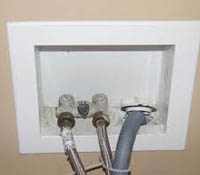Drainage for Washing Machines
In order for a washing machine to drain properly, it needs to have a fully functional drain hose. If there is any issue with a machine's drain hose, it can cause the washing machine to stop working or to leak as the machine is running. While no homeowner wants to have a washing machine that doesn't work or leaks, the good news is it's easy to ensure your washing machine drains properly by installing a new drain hose.
How Does Drainage for Washing Machines Work?
The drain hose attaches to the back of a washing machine. This hose is responsible for connecting the washing machine to the drain pipe. In some cases, an older drain hose may simply wear out and stop handling this important connection properly. In other cases, the issue may actually be with how the hose is placed or attached. If a connector other than a retaining clamp is used on the hose, it can interfere with the washing machine's drainage by causing air to get trapped in this area.
How to Begin the Drainage Hose Installation
Prior to beginning the installation process, you will want to make sure that you have:
- New drain hose
- Zip ties
- Spring clamp
- Pliers
Once you have these materials and tools, you will want to use warm water to wet one end of the drainage hose. The reason this end needs to be wet is so it can easily slip over the drain port of the washing machine. After it’s wet, you will want to use your pliers to hold down the spring clamp's tabs. You can then slip the clamp over the end of the drainage hose. Once the clamp is over the drainage hose, you can release the tabs.
Additional Connections and Completing this Drainage Installation
The next task you'll want to complete is locating the washer's drain port and then putting the hose's end over it. The proper way to connect these two elements is by continuing to slip the drainage hose over the port until the port's top comes into contact with the hose's ribs. After making this connection, you'll want to once again use the pliers to push down the spring clamp's tabs. You can then slip the clamp along until it reaches the area that's actually marked "clamp."
Once you release the clamp's tabs, you can take the molded hook pipe and put it into the hose's other side. You'll want to properly secure this connection by pressing the hose all the way down until it's between the retaining tabs. After this connection has been properly attached, you can put the hose's hook end into the drain line. To avoid any future washing machine drainage problems, make sure you use one or more zip ties to secure the hose in place. Attaching it to the pipe will ensure it doesn't come loose when the washing machine is running. Once this connection is securely in place, you'll be ready to start using your washing machine.

